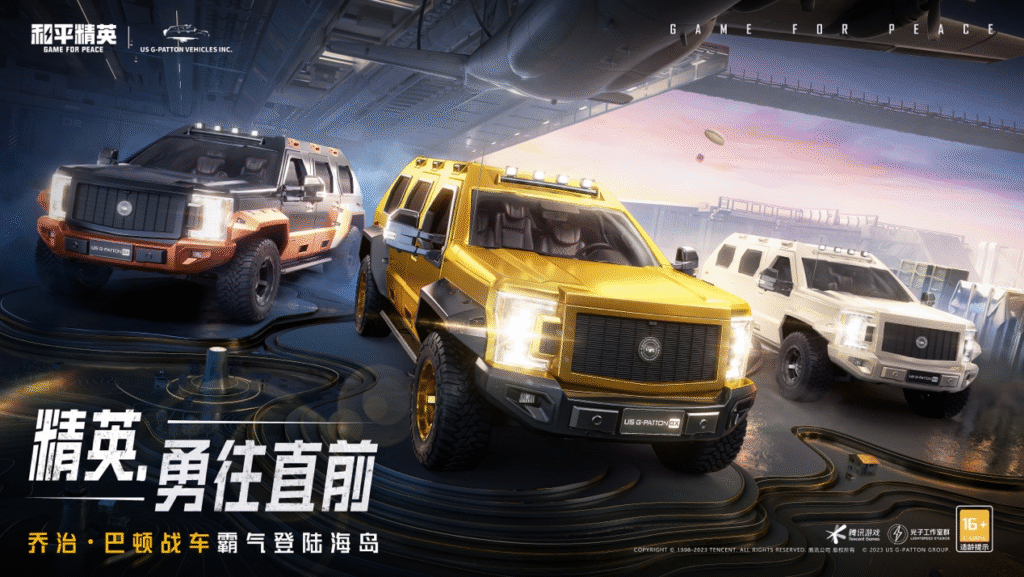On July 21, 2025, the Hangzhou Intermediate Court delivered a second-instance ruling in the trademark infringement and unfair competition dispute concerning the George Patton brand Case No.: (2024) Zhe 01 Min Zhong 10520. This landmark case, recognized as the first involving metaverse virtual reality trademarks, has garnered widespread attention. The court not only upheld the claims of traditional trademark infringement and unfair competition but also determined that the virtual George Patton vehicle equipment used in the game Peace Elite—authorized by the infringing party—qualifies as goods similar to the real-world George Patton vehicles, thereby constituting trademark infringement. This judgment is significant in clarifying whether trademark protection for physical products can extend into virtual environments.
Case Summary
In the George Patton case, the defendants were accused of multiple infringing actions. For the purpose of this discussion, the relevant facts are summarized as follows: George Patton (G. Patton) is an ultra-luxury armored off-road vehicle brand developed by US Specialty Vehicles LLC. Xuanwo Company holds the trademark rights for this brand in China under Class 12, covering goods such as electric conveyances, trucks, automobiles, and electric vehicles. The registered trademarks include No. 23206796 (Figurative Mark), No. 27181877 (乔治巴顿 / George Patton), and No. 23206798 (G. PATTON). Without authorization, Qiaoba Taifeng Company and others, claiming to represent the George Patton automotive brand, collaborated with Tencent Company to launch a co-branded George Patton vehicle and use the associated trademarks within the game Peace Elite. Investigations by the IP team revealed that while Peace Elite is free to download, users are required to pay several hundred RMB to obtain the George Patton vehicle item featured in the game.

Pursuant to Article 57 of the Trademark Law of the People’s Republic of China, establishing trademark infringement requires meeting all of the following criteria: 1) the allegedly infringing sign is identical or similar to the registered trademark) the goods or services involved are identical or similar to those for which the trademark is registered; and 3) the use is likely to cause confusion among consumers. In this case, the similarity between the alleged infringing signs and the rights holder’s trademarks was largely undisputed. However, the goods in question were clearly not identical to those covered by the registered trademarks. The primary issue was whether the virtual car model used in the game could be considered similar to the automobile goods classified under Class 12, which are protected by the trademarks involved. The first-instance court (Xiaoshan Court) and the second-instance court (Hangzhou Intermediate Court) reached differing conclusions on this matter.
First-Instance Court’s Analysis: Determination of Non-Similar Goods
The Xiaoshan Court concluded that the goods were not similar, based on the following reasoning: The Trademark Law categorizes goods because trademarks are registered, managed, and protected according to these classifications. When assessing similarity, the key consideration is whether the trademark’s use would lead the relevant public to believe that the goods or services come from the same source or that there is a specific connection between their providers. In this case, the virtual car model within the game lacks the transportation function inherent to real automobiles. Additionally, the industries involved, sales channels, and target consumers differ significantly. Purchasing the in-game item does not impact the market for Xuanwo Company’s automobile products. Therefore, the relevant public would not likely associate the virtual item with the physical automotive goods as originating from the same source or having a particular connection. Consequently, the goods or services involved fall outside the scope of protection afforded by Xuanwo Company’s trademarks. As a result, authorizing co-branding within the game does not constitute trademark infringement against Xuanwo Company.
Reasoning of the Second-Instance Court: Determination of Similar Goods
The Hangzhou Intermediate Court concluded that the goods in question are similar, offering the following rationale:
- In this case, although there are clear differences between the virtual car prop used in the game and real-world automobiles—such as their functions, intended purposes, production sectors, sales channels, and target consumers—there remains a notable degree of overlap and convergence between them. For example, in terms of function and purpose, the in-game vehicle, as a virtual asset, allows players to quickly reach designated locations or participate in driving competitions within the game, serving a role comparable to the passenger transport function of actual automobiles. Additionally, the virtual vehicle can simulate the appearance and interior design of a real car, creating an association with automotive products through its visual representation.
- Regarding sales channels and consumer groups, while real automobiles are primarily sold through specialized outlets like dealerships targeting car buyers, the virtual game asset is aimed at gamers. However, players who engage with the virtual vehicle may develop an interest in or subsequently purchase related automotive products, indicating potential overlap in the consumer base.
- Concerning public perception, promotional efforts by the third party and Qiaoba Taifeng Company emphasized “George Patton” as an off-road vehicle brand, highlighted the co-branding relationship and brand value, and described the collaboration on their official website as “officially licensed” and “faithfully recreating the rugged appearance of the real George Patton vehicle.” They also promoted George Patton alongside well-known automotive brands such as Maserati, Aston Martin, and Tesla. As a result, the relevant public exposed to this promotional content and the game is likely to recognize “George Patton” as an automotive brand and may mistakenly believe that the brand has authorized the related goods or activities.
Therefore, under certain circumstances, virtual game vehicle assets and real-world automobile goods may be considered similar. Taking into account the high level of simulation and the promotional context specific to this case, the Hangzhou Intermediate Court determined that the virtual vehicle in the game and the real automobile goods are similar, and that the alleged conduct constitutes trademark infringement. This judgment clarifies the connections between virtual and physical goods in terms of function, audience, and promotional influence, offering important judicial guidance for trademark protection in digital environments such as the metaverse. It also provides valuable precedent for future cases of a similar nature.
